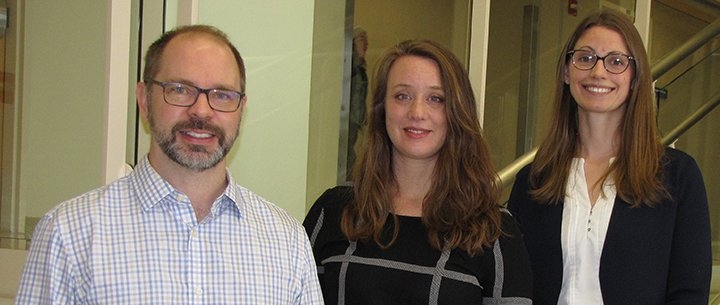Biomedical research at SDSU lands millions to advance work
May 9, 2022
This paid piece is sponsored by South Dakota Biotech.
Biomedical research being done at South Dakota State University, specifically in the area of inflammation, has received millions in new federal funding.
The $10.8 million award from the National Institutes of Health will fund work in the newly created Center of Biomedical Research Excellence for five years and potentially could be renewed for a second and third five-year period.
“What the center aims to do is really build strong biomedical research at SDSU,” said Adam Hoppe, the primary investigator and center director.
“Without a medical school, biomedical research at SDSU has never had a sharp focus. This project creates a focused and cohesive center that will accelerate the productivity and infrastructure needed for biomedical research at SDSU.”
In addition, this center will involve researchers at the South Dakota School of Mines and Technology in Rapid City, building on an existing partnership. The BioSNTRii also will collaborate with biomedical research efforts at the University of South Dakota, Sanford Research and the Mayo Clinic to help advance inflammation-related research within the region.
“This is a huge win for our state, for higher education and for the biotech industry,” said Joni Ekstrum, executive director of South Dakota Biotech.
“The work that will be achieved through this grant will bring a new level of sophistication to our involvement in the biomedical field and position us for future research and industry growth.”
The grant will fund the research of current faculty members, bring on new researchers and staff, and add equipment to allow for more sophisticated research.
“In the first phase of this project, we will hit the ground running,” Hoppe said.
“We have research project leaders in place, and they have begun to scale research efforts, including hiring additional technicians and recruiting students. Their efforts are aimed at elucidating fundamental mechanisms by which cells communicate with each other during inflammation. In addition, we are working to develop our core facilities in next-generation sequencing and imaging that will support this work.”
Adam Hoppe, principal investigator and a chemistry and biochemistry professor; Natalie Thiex, an associate professor in biology and microbiology; and Darci Fink, associate professor in chemistry and biochemistry
Daniel Scholl, vice president for research and economic development at SDSU, said, “This is an exciting development for the university and recognizes the great work already taken place to put SDSU in a position to receive this prestigious award from the National Institutes of Health. It also is a tribute to Hoppe and collaborators’ leadership, vision and persistent hard work.”
Hoppe particularly cited Radhey Kaushik, head of the biology and microbiology department, for “playing an integral role in developing the proposal and contributing to the project by providing his immunology expertise and administrative support.”
Hoppe added that the new center is a progression of the South Dakota BioSystems Networks and Translational Research center that was created in 2013.
Then, the state awarded the center $12 million over six years when it was selected as the South Dakota Established Program to Stimulate Competitive Research submission to the National Science Foundation Research Infrastructure Improvement Track I program. That funding ended in 2018, but smaller grants and university investment have kept the work active.
“I think that BioSNTRii, with its focus on inflammation, fits well with the current biomedical industry space in South Dakota,” Hoppe added.
“Inflammation is central to the mechanism of action of many therapeutics, including therapeutic antibodies, in addition to being at the heart of many acute and chronic diseases. The BioSNTRii will train undergraduate and graduate students that will contribute to existing biomedical industry and potentially start new companies and activities in the region. In addition, it expands the capabilities and university resources needed to support a thriving biomedical research community.”
Award to develop junior researchers
The new award will serve as an accelerator to advance the work of junior researchers to the level that they can received sustained funding from the NIH and NSF, Hoppe said.
The work of two research leaders was identified in the proposal, and a third one is to be solicited. The two current researchers whose work will be funded are Natalie Thiex, an associate professor in biology and microbiology, and Darci Fink, an associate professor in chemistry and biochemistry.
Jaime Lopez, an assistant professor in biology and microbiology, was part of the team that developed the proposal; however, he successfully secured sufficient independent funding through the NIH and the NSF to graduate from the Center of Biomedical Research Excellence program before it began.
Thiex studies macrophages
Thiex’s work focuses on macrophages, white blood cells that go to work during wound repair.
“Macrophages are consistently cleaning debris out of the tissue,” said Hoppe, a chemistry and biochemistry professor. “They are the most important cell in regulating inflammatory response. There is a balance between activating inflammation (to begin the healing process) and resolving inflammation,” which, when unchecked, increases the risk for various diseases.
“One of the gaps in knowledge is exactly how do cells at the wound site communicate with each other to begin response,” Hoppe said.
Thiex, who already has done work in this area through smaller NIH grants, will attempt to fill that knowledge gap through expanded research made possible by the $10.8 million award.
Fink studies lymphatics
Fink, who also has received smaller NIH awards, studies lymphatics and the formation of lymphatic vessels. The lymphatic system is a network of vessels and organs that regulates the amount of fluid in the human body and defends it against infections.
“At the site of inflammation, you can grow new lymphatic vessels, which drain fluid and regulate swelling and the inflamed tissue site,” Hoppe said. “What remains a mystery is how these cells grow and organize themselves into functional structures and how they communicate with each other and the tissue they are growing into.
“When these vessels do not grow or do not grow properly, you can have chronic inflammation or chronic swelling.”
New equipment in budget
Finding a third project leader will be a lengthy process involving advisory committee recommendations and NIH approval. However, Hoppe said any junior faculty member at SDSU who has research relating to inflammation at the cellular or molecular level would be eligible to apply.
It is expected two additional researchers would be hired through external searches during the five-year grant period. The budget also calls for hiring technicians and graduate research assistants.
Equipment and facility upgrades also are planned. The jewel is a $300,000 confocal microscope that will be housed in the Functional Genomics Core Facility in the McFadden Biostress Laboratory and will help with the imaging of cellular and molecular organisms during inflammation, Hoppe said.
Another purchase will be an addition to existing equipment. That $100,000 item will permit single-cell sequencing technology so researchers can determine gene expression within individual cells, informing understanding about how they communicate during inflammation.
Both purchases should take place during the course of the year. There also will be an immediate $300,000 update to the small animal research facility, which uses mice, within the university’s animal resource wing headed by university veterinarian Dr. Michele Mucciante.
Partnerships to advance projects
Hoppe notes the development of genomic sequencing has created tremendous amounts of information and the need for experts in these areas to assist in the work of researchers such as Thiex and Fink. Hence, the center includes experts such as Jose Gonzalez, who runs the gene sequencing lab on campus, and Xijin Ge, a bioinformatician in the mathematics and statistics department.
While the new Center of Biomedical Research Excellence is focused on SDSU, it will expand existing partnerships with South Dakota Mines and the Biomedical Research Infrastructure Network at the University of South Dakota that were part of the original South Dakota BioSystems Networks and Translational Research center.
Also part of the new award are formal arrangements with mentors at other universities to provide guidance to researchers and an advisory committee of experts from across the country. There also is a speaker exchange with the Mayo Clinic in which faculty members exchange findings, Hoppe said.
“Basic biomedical research has always been a part of what we have been doing at SDSU. This is taking it to the next level.”








